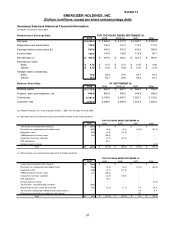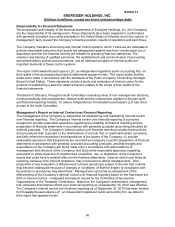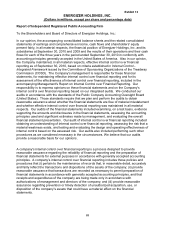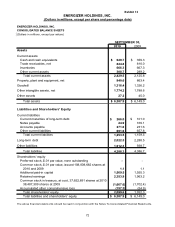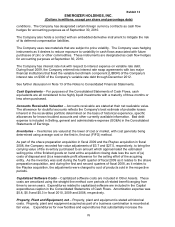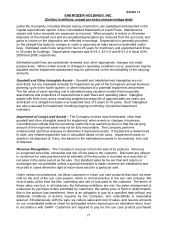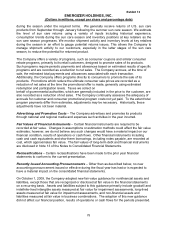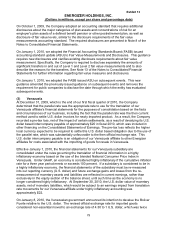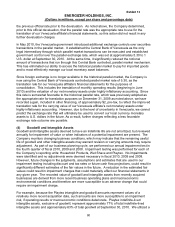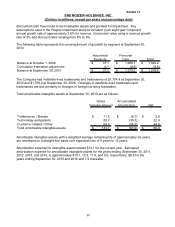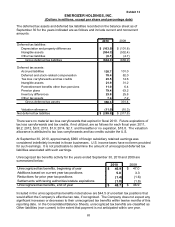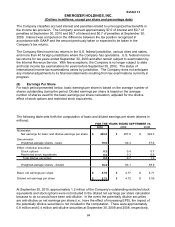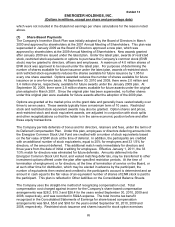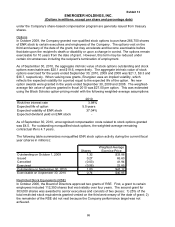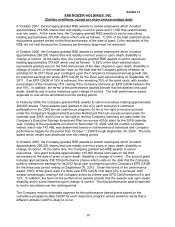Energizer 2010 Annual Report Download - page 87
Download and view the complete annual report
Please find page 87 of the 2010 Energizer annual report below. You can navigate through the pages in the report by either clicking on the pages listed below, or by using the keyword search tool below to find specific information within the annual report.
Exhibit 13
ENERGIZER HOLDINGS, INC.
(Dollars in millions, except per share and percentage data)
77
useful life of property, including interest during construction, are capitalized and reported in the
Capital expenditures caption in the Consolidated Statements of Cash Flows. Maintenance,
repairs and minor renewals are expensed as incurred. When property is retired or otherwise
disposed of, the related cost and accumulated depreciation are removed from the accounts, and
gains or losses on the disposition are reflected in earnings. Depreciation is generally provided
on the straight-line basis by charges to costs or expenses at rates based on estimated useful
lives. Estimated useful lives range from two to 25 years for machinery and equipment and three
to 30 years for buildings. Depreciation expense was $119.3, $111.0 and $121.4 in fiscal 2010,
2009 and 2008, respectively.
Estimated useful lives are periodically reviewed and, when appropriate, changes are made
prospectively. When certain events or changes in operating conditions occur, asset lives may be
adjusted and an impairment assessment may be performed on the recoverability of the carrying
amounts.
Goodwill and Other Intangible Assets – Goodwill and indefinite-lived intangibles are not
amortized, but are evaluated annually for impairment as part of the Company's annual business
planning cycle in the fourth quarter, or when indicators of a potential impairment are present.
The fair value of each reporting unit is estimated using valuation models that incorporate
assumptions and projections of expected future cash flows and operating plans. Intangible
assets with finite lives, and a remaining weighted average life of approximately six years, are
amortized on a straight-line basis over expected lives of 5 years to 15 years. Such intangibles
are also evaluated for impairment including ongoing monitoring of potential impairment
indicators.
Impairment of Long-Lived Assets – The Company reviews long-lived assets, other than
goodwill and other intangible assets for impairment, when events or changes in business
circumstances indicate that the remaining useful life may warrant revision or that the carrying
amount of the long-lived asset may not be fully recoverable. The Company performs
undiscounted cash flow analyses to determine if impairment exists. If impairment is determined
to exist, any related impairment loss is calculated based on fair value. Impairment losses on
assets to be disposed of, if any, are based on the estimated proceeds to be received, less cost
of disposal.
Revenue Recognition – The Company's revenue is from the sale of its products. Revenue
is recognized when title, ownership and risk of loss pass to the customer. Discounts are offered
to customers for early payment and an estimate of the discounts is recorded as a reduction of
net sales in the same period as the sale. Our standard sales terms are final and returns or
exchanges are not permitted unless a special exception is made; reserves are established and
recorded in cases where the right of return does exist for a particular sale.
Under certain circumstances, we allow customers to return sun care products that have not been
sold by the end of the sun care season, which is normal practice in the sun care industry. We
record sales at the time the title, ownership and risk of loss pass to the customer. The terms of
these sales vary but, in all instances, the following conditions are met: the sales arrangement is
evidenced by purchase orders submitted by customers; the selling price is fixed or determinable;
title to the product has transferred; there is an obligation to pay at a specified date without any
additional conditions or actions required by the Company; and collectability is reasonably
assured. Simultaneously with the sale, we reduce sales and cost of sales, and reserve amounts
on our consolidated balance sheet for anticipated returns based upon an estimated return level,
in accordance with GAAP. Customers are required to pay for the sun care product purchased


